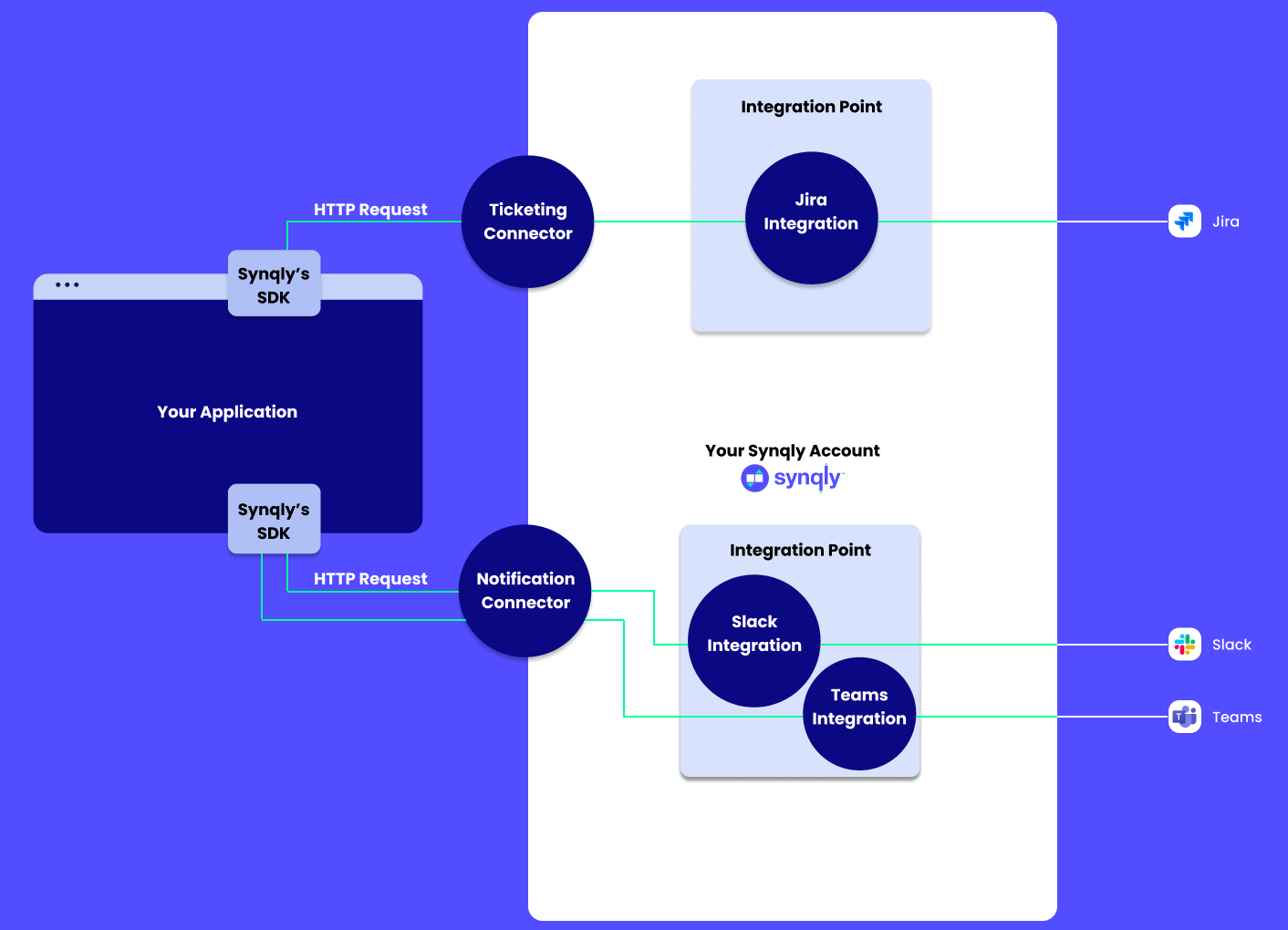Welcome to Synqly! Our platform provides a simple, secure, and sustainable interface for integrating with third-party platforms, enabling you to connect once and immediately give your users access to multiple services. Synqly implements unified API that translates requests and responses from our model to supported third-party APIs and services.
Understanding this terminology will help ensure you have a smooth setup process with Synqly.
- Connector: A unified API and data model for each category of
providers(e.g., Messaging, Ticketing, Storage).connectorsoffer a single interface for multipleprovidersin the same category. - Provider: A specific third-party service within a
connector, such as Jira or ServiceNow within the ticketingconnector. Synqly translates your requests to interact with manyprovidersusing a standardized model. - Tenant: Your customer who can access Synqly's API via an "
account". - End User: The customer of your customer, someone who registers
integrations(e.g., connecting Jira to Synqly).
- Organization: The top-level unit for managing your Synqly integration. An
organizationallows you to manage multipleaccounts. Synqly customers typically run multi-tenantapplications, with eachtenantsupporting manyend users. - Member: A
memberof theorganization. Depending on amember'spermission they can modify data such as theorganizationit self,accounts, and all of theaccountsdata. - Account: An account under your
organizationdedicated to managing data for a singletenant. Resources foraccountsare segregated to ensure data privacy. - Integration Point: It acts as an allow/deny list of available
providersfor yourend usersto setup.Integration pointshelp you control your product's integrations by providing additional features and configuration. - Integration: The connection to a
provider, set up via Synqly Connect or Synqly's API/SDK. Once configured, anintegrationenables interaction with the targetprovidervia Synqly's Connector APIs. Eachintegrationbelongs to anaccountand can be associated with anintegration pointto provide additional features and configuration.
All communication with the Synqly API requires authentication, and this is done with bearer tokens. These tokens are restricted to work with a minimal set of API resources. For more information on Tokens, refer to Authentication.
Each of your tenants is represented as an account in Synqly. We recommend that for each of your tenants your backend should create one account in Synqly using the Accounts API. You may create more than one account per tenant, but unless you have a need for the added security we recommend keeping it to one.
Data is segregated to prevent any crossover between accounts or organizations . You may also create accounts for internal use such as for testing, staging, and sales purposes. Each account has a unique ID.
Each account can contain many integration objects, each of which encapsulates a connection to a provider. Once configured, an integration lets you use the relevant Synqly connector API to send requests to the target provider. For example, after creating an integration using the Jira provider, you may use the Ticketing API to create, update, and delete Jira issues.

Create an
Organization:- Contact us to schedule a demo
- We'll provision you with an
organizationto get you started
Save Your Access Token and
OrganizationID:- After creating your
account, the browser will display yourorganizationaccess token andorganizationID. - Save the Token, as this is the only time it will be shown in the UI!
- After creating your
Explore Synqly's APIs:
- With your
organizationID and access token, you can try out Synqly's APIs. - Use either the provided SDKs or direct HTTP calls.
- Some API calls require spesific tokens. Check out the Authentication docs for more info.
- With your
Select which interface you want to use, SDK or HTTP. The SDK is the preferred method to interact with Synqly.
For a list of all currently supported SDKs, refer to our Synqly SDK guide.
If your application is written in a language that does not yet have a Synqly SDK, head to Getting Started with Direct HTTP to learn how to use Synqly via a direct HTTP client such as curl.